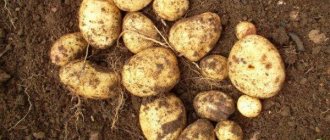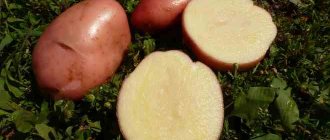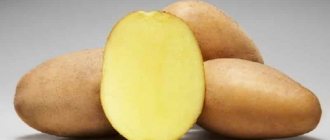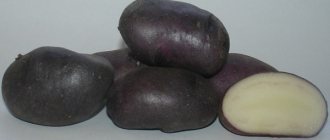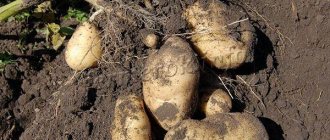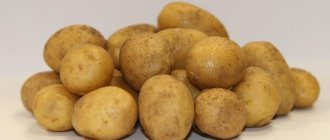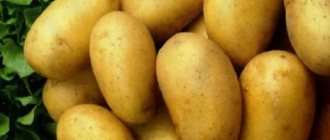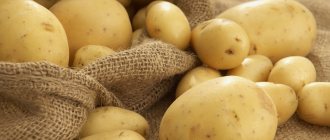Wendy's potatoes are a mid-season table variety. It is intended for cultivation both on individual plots and in industrial areas of large agricultural companies. Since the tubers lend themselves well to mechanical cleaning, the variety is widely used in large-scale production of potato products.
Description of Wendy's Potatoes
The variety was bred in Germany. During its selection, the popular Gala potato was used as a basis. The originator of the variety was. In 2014, the culture was included in the State Register of Breeding Achievements of the Russian Federation, with permission to grow in the Central region of Russia (Tula, Ryazan, Kaluga, Vladimir, Bryansk, Ivanovo, Moscow, Smolensk regions).
The distinctive characteristics of the Wendy potato variety are excellent presentation, high yield, accelerated adaptation and large tuber sizes. The Wendy variety exhibits high resistance to nightshade diseases. Suitable for mechanical harvesting.
Potato plants are stem type, medium height. The bushes grow erect, moderately spreading. The leaves of the variety are large in size and light green in color. The potato has a medium-small corolla and the color of the plant is white.
The Wendy variety has a well-developed root system. In one nest you can find 6 - 11 oval-shaped tubers with yellow skin. The eyes are small in size and located shallowly. The harvested potatoes weigh 90 - 120 g.
Description and characteristics of the variety
Wendy's potatoes are included in the line of mid-early varieties. The vegetative stage lasts 70–100 days. Potatoes are adapted to temperature changes and bear fruit in heat and drought. Shows maximum productivity in loose nutrient soil.
A breeding group from Germany participated in the development of the variety. The basis for the creation was the Gala standard. The originator of potatoes is the famous agricultural company Norica Nording. The variety has been included in the State Register since 2014. Potatoes have excellent consumer and taste qualities. The assessment of the State Sorting Commission is 4.7 points.
Active cultivation is carried out in the Central and Central Black Earth regions, in the south. Possible cultivation in the northern regions.
The bushes are vigorous and erect. Spreading and foliage are moderate. The tops are durable and do not break. Leaf blades are pale green. There is a slight waviness. The inflorescences have white buds, but there are few berries.
On branched roots, 25 to 30 elongated tubers are formed and formed. The dimensions are uniform (convenient for mechanized digging of crops).
Marketability is in the range of 78–95%.
What is useful to know about tubers:
- average weight - 90–130 g;
- starch content - 14.5–15%;
- surface - dark yellow, with a brownish tint;
- the pulp has a dense texture and is colored bright yellow;
- many carotenoids, amino acids, fiber and macroelements;
- ocelli - few, located 1–3 mm.
Table use - type B. Tubers can be fried, boiled, baked, stewed (on their own or with other vegetables). Potatoes are used for processing and production of semi-finished food products.
Taste qualities of potatoes
Wendy's potatoes taste good. The variety belongs to cultivated type B. Its pulp has a rather dense structure. After heat treatment when cutting, the tubers do not significantly change their color. From a culinary point of view, the variety is considered universal, suitable for use in preparing various dishes. Wendy's potatoes can be fried, boiled and baked. It is also well suited for making soups and salads.
Information! The starch content of Wendy's potatoes is about 14 – 15%.
Strawberry Wendy 5pcs
Wendy is a highly productive strawberry variety from Nova Scotia. The ripening period is ultra-early. Characterized by good transportability, withstands long-term storage. The fruits are large, wedge-shaped, bright, classic red, shiny, of the same size, weighing 30–35 g. The pulp is elastic, juicy, exudes a pleasant aroma, and has excellent taste. The bush is well formed, with a lot of leaves. The stalks are located at the same level with the foliage. Shows resistance to late blight and powdery mildew, as well as heat and frost resistance.
Article on the topic: Potato variety “Jubilee Zhukov” - description and photo
Pros and cons of Wendy's potato variety
Like any crop, the Wendy variety has its advantages and disadvantages.
The advantages include:
- Low starch content;
- High levels of vitamin and mineral composition: the variety is suitable for use as a product of the dietary group;
- Ripe potatoes have a regular round shape, which greatly simplifies harvesting, especially mechanically;
- The skin of root vegetables is dense, which protects it from damage during long-term transportation or storage;
- The variety demonstrates high productivity.
The disadvantages of the Wendy variety include:
- Dependence on irrigation: soil moisture levels should be constantly monitored;
- The Wendy variety is characterized by slow emergence.
Advantages and disadvantages
Pros:
- friendly early ripening harvests;
- resistance to mechanical damage (during transportation);
- wonderful taste characteristics;
- low susceptibility to infectious diseases;
- endurance to adverse weather;
- productivity indicators;
- new potatoes already in June;
- dense high-quality pulp texture.
Minuses:
- the importance of proper hilling;
- loves good moisture;
- the need for fertile soil composition;
- preventive protection against the Colorado potato beetle.
Planting and caring for Wendy's potatoes
Caring for the Wendy variety has several nuances. To reap a large harvest, you must adhere to the rules of soil preparation, planting, watering, fertilizing, and disease prevention.
Selection and preparation of a landing site
The ideal place to plant Wendy's potatoes is sandy loam soil. It is also important that the soil contains sufficient fertilizer. To ensure easy formation of young fruits, potatoes require light soil. When growing in heavy soil, the yield may be significantly lower, the tubers will have an irregular shape, which will increase the amount of waste. If the soil at the planting site has a heavy structure, it must be diluted with river sand.
Advice! When planted early, the plant better takes advantage of the moisture reserves present in the soil, which is especially important for areas that are not provided with sufficient watering. Thus, planting at the beginning of May makes it possible to obtain seedlings already at the end of the month, while planting after May 20, even in warm weather conditions, produces seedlings by June 15.
Preparation of planting material
Before you begin planting the planting material, it must be placed in a warm room for 24 hours, with sufficient access to sunlight. This will allow the potato skins to harden, which will further promote good plant growth.
In addition, direct sunlight makes it possible to disinfect the sowing material from bacteria and harmful microorganisms. It is necessary to plant those tubers whose sprouts have reached at least one centimeter in size. It is better not to use tubers with too long sprouts: due to their fragility, they are unsuitable for planting.
Important! Since the Wendy potato variety sprouts slowly, it is recommended to pre-germinate the tubers and use growth stimulation with biostimulants.
Landing rules
To achieve optimal quality of the Wendy's potato harvest, you should follow the rules of agricultural technology:
- Use tubers of standard sizes: deviations from the standard should not exceed 5 cm.
- Before the period when the soil is covered with tops, the planting must be mulched.
- To ensure uniform lighting, the planting should be located in the direction from north to south.
- Follow the recommended planting pattern: for Wendy's potatoes, the distance between beds should be 40 cm, with a distance between bushes of approximately 50 cm.
- The planting depth depends on the type of soil: on light soils it should be from 10 to 12 cm, on heavy loamy soils - from 8 to 10 cm, on heavy clay soils - from 4 to 5 cm.
- Avoid thickening in cases where planting was not carried out using fine planting material.
Watering and fertilizing
The Wendy variety requires watering at least three times during the season. At the same time, the frequency of precipitation and soil moisture are taken into account. It is better to water the plants in the morning or evening. When watering, a point approach is used, that is, water is delivered to each bush. This is also convenient because it is possible to selectively regulate the watering of specific bushes.
Each bush needs to be supplied with a maximum of 4 liters of water, which should flow to the roots in portions, 1 liter per nest. So, after the watered bush has completely absorbed the moisture, another liter of water is added to it. This can be done with a bucket or watering can, but it is optimal to use a hose with a sprayer at the end (this will help prevent soil erosion). After watering the top layer of soil, having passed one row, they move to another, after watering which they again return to the first row and repeat the procedure.
As a top dressing, potatoes are sprinkled with wood ash after planting.
Hilling
Hilling Wendy's potatoes is necessary for active growth. The event allows you to protect the bushes from temperature changes. This is especially true for areas with low air temperatures.
After the sprouts reach 10 cm, you can perform the first hilling. The second is carried out after the plants have risen to 45 cm in height. It is necessary to form a hill of soil around each bush. The best time to perform the procedure is the morning or evening after watering.
Diseases and pests
The main problem of the Wendy variety is rhizoctonia. Potatoes are not afraid of the following diseases:
- Scab;
- Late blight;
- Viral infections.
The plant shows average resistance:
- To the nematode;
- Twisting of sheet plates;
- Potato cancer;
- Late blight of tops.
The Wendy variety is neutral to the Colorado potato beetle. To protect against insects, plants must be treated with a special compound. The insecticidal preparations usually used are Colorado, Aktara, Killer, and Euphoria. As a natural, accessible remedy against the Colorado potato beetle, dill is planted between potato beds.
To prevent diseases, monitor the quality of feeding. Basic root feeding:
- Bird droppings - in the furrows between the beds, in a solution with water 1:10, respectively;
- Urea - at the root, before the first hilling, half a liter of solution per bush: dilute a tablespoon in 10 liters of water, first loosen the bud;
- Mullein - between the rows: a liter of manure per bucket of water;
- Herbal infusion - along the perimeter of the hole, without touching the stem: from any weeds, soaking and fermenting them in water, then diluting them to the color of light tea; It is best to use in the evening in June, when the plant's need for nitrogen is high.
- Mineral fertilizing, solutions (20g per 10l of water): ammonium nitrate; mixtures of nitrogen, phosphorus and potassium fertilizers in a ratio of 1:1:2.
Pests and diseases
Potato variety Wendy is characterized by resistance to the following diseases:
- scab;
- late blight;
- viral infections.
The plant has average resistance to leaf blight, potato canker, nematode, and leaf curl. These potato diseases can be prevented by treating the bushes with fungicide solutions. “Ditamin M-45”, “Artsedil”, “Kuproksat” have proven themselves well. The drugs should be used according to the instructions on the packaging.
Wendy's potatoes also suffer from attacks by harmful insects: mole crickets, wireworms, and Colorado potato beetles. To protect the vegetative part, as a rule, insecticides “Killer”, “Colorado”, “Aktara” are chosen. Dill placed between rows of potatoes helps as a natural remedy for the Colorado potato beetle.
Attention! Chemicals are allowed to be used at least a month before harvest.
To avoid the appearance of parasites and dangerous diseases, it is necessary to take preventive measures:
- Treating the soil before planting Wendy's potatoes with antifungal agents.
- Systematic spraying of bushes with insecticides.
- The use of preparations containing copper during the period of mass manifestations of late blight.
- Changing root crop planting sites.
- Removing soil residues from the surface of the fruit so as not to create favorable conditions for the growth of bacteria.
Harvesting and storage
From the moment the first shoots appear until the potato harvest, approximately 70 - 80 days pass. If you don't take into account the automated method, there are two ways to harvest Wendy's potatoes:
- With a pitchfork. To reduce the risk of damage to tubers and eliminate the need for leveling the ground, it is better to use a fork.
- If you dig potatoes with a shovel, then there is a high risk of damaging the tubers. During periods when the soil is too dry, it is better to use this particular tool.
To increase the shelf life of tubers, it is necessary to remove the tops of the plants a week before harvesting. You can store potatoes both in boxes and in bags: in the darkest possible place, ideally in cellars, in conditions of low temperature.
Important! Before storing potatoes for long-term storage, they must be thoroughly dried.
The Megasad online store will refund the entire cost of the product in the following case:
— The quality of the received plants does not meet expectations (the received plant is rotten, dry or damaged).
— The parcel did not lie in the post office for more than 5 days from the moment of arrival and notification of this to you.
How to get a refund?
— You must contact our company no later than 7 days from the date of receipt of the order
— You send photo evidence to our email (for example, a damaged seedling, and always a photo of the order invoice from our store). There is no need to send the plant itself.
Article on the topic: Potato variety “Zhigulevsky” - description and photo

